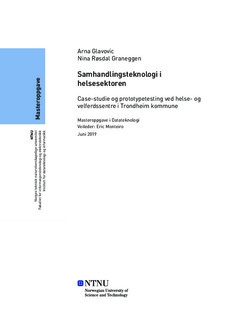| dc.contributor.advisor | Monteiro, Eric | |
| dc.contributor.author | Glavovic, Arna | |
| dc.contributor.author | Graneggen, Nina Røsdal | |
| dc.date.accessioned | 2019-10-31T15:17:08Z | |
| dc.date.available | 2019-10-31T15:17:08Z | |
| dc.date.issued | 2019 | |
| dc.identifier.uri | http://hdl.handle.net/11250/2625829 | |
| dc.description.abstract | Norge går inn i en framtid med demografiske problemer. Som følge av at andelen eldre
i befolkningen øker, er det forventet store bemanningsproblemer i helsesektoren. Norge har
allerede underbemanning, altså vil problemet fortsette å øke i omfang i årene framover. Dette
gjør at vi er nødt til å utnytte ressursene på en smartere måte. Teknologi er en løsning som
har potensial i å lette hverdagen til helsepersonell, slik at de har mer tid til pasientrettet
arbeid. Et av tiltakene er sensorteknologi som kan bistå helsepersonell med overvåkning av
pasienter. Sensorteknologi benyttes ved helse- og velferdssentre i Trondheim kommune, og
inkluderer et alarmsystem. Pasienter, ansatte og sensorer kan utløse alarmer som mottas
i en alarmtelefon. Dette forskningsprosjektet har studert systemet som det er i dag, hvor
alarmtelefonene er av en eldre type DECT-telefon med fysisk tastatur. Masteroppgaven tar
for seg hvordan samhandling ved helse- og velferdssentrene kan forbedres når alarmtelefonene
erstattes med en applikasjon på smarttelefon.
Det ble gjennomført et empirisk studie hos tre helse- og velferdssentre i Trondheim kommune.
Ved bruk av observasjon og intervju av ansatte, samt observasjon av workshop i kommunen,
var formålet å avdekke problemområder for samhandling. Basert på resultatene fra det empiriske
studiet ble det utviklet en prototype for ny applikasjon på smarttelefon. Prototypen
ble brukertestet over to iterasjoner med ansatte. Prototypen anses som et forslag til hvordan
samhandling ved helse- og velferdssentre kan forbedres.
Til slutt konkluderer oppgaven med at dagens løsninger framstår som utdaterte, lite brukervennlige
og individuelt orienterte, noe som i stor grad hindrer den gode samarbeidskulturen
ansatte allerede innehar. Innføring av nye smarttelefoner har stort potensial i å forbedre
samhandling, ved å flytte fokus fra det individuelle til det kollektive. Det er videre anbefalt
å fokusere på et brukersentrert design i møte med framtidens utfordringer. | |
| dc.description.abstract | Norway is facing a future with demographic problems. An increasing portion of seniors in the
population leads to staffing issues in the healthcare industry. Norway is already experiencing
understaffing of health employees, so the problem will expectedly increase in the years to
come. This makes us have to utilize the resources available in a better way. Technology
is a solution that has the capability of reducing workload. One of the initiatives is sensor
technology that can assist employees with monitoring of patients. Health and welfare centers
in Trondheim municipality has an infrastructure of sensor technology installed, containing an
alarm system. Employees are carrying telephones that receive alarms triggered by patients,
employees and sensors. The phones used today are outdated DECT-telephones, with a small
screen and physical keyboard. This thesis addresses how cooperation in health and welfare
centers can improve when a new smartphone application replaces the telephones used today.
In this master thesis, an empirical study was conducted at three healthcare units in Trondheim
municipality. By observing and interviewing employees, in addition to observing a workshop
arranged by the municipality, the purpose was to uncover problem areas of cooperation.
Based on the results of the empirical study, a prototype was developed and user-tested in an
iterative approach with employees. The prototype is a proposal of how cooperation at health
and welfare centers can improve.
At last, the thesis concludes that today’s technology solutions appear to be outdated, not
user-friendly and individually oriented, which greatly hinders the cooperation culture employees
already have. An introduction of new smartphones has a great potential in improving
cooperation, by moving the focus from the individual to the collective. The thesis also suggests
that upcoming work in the domain should focus on user-centered design, to succeed in
developing new technology that contributes to solving the problems we are facing. | |
| dc.language | nob | |
| dc.publisher | NTNU | |
| dc.title | Samhandlingsteknologi i helsesektoren | |
| dc.type | Master thesis | |
